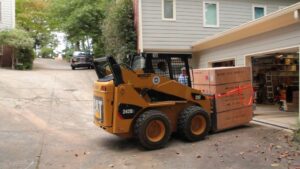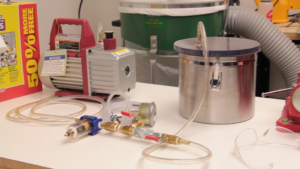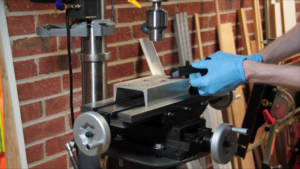Category: Uncategorized
Parts and Operation
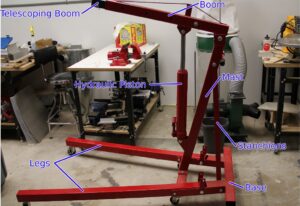 |
| Crane Parts |
There are not many parts to these cranes and assembly is simple (with the exceptions noted below). These cranes have a simple frame with arms which fold up for storage. A hydraulic ram supplies the mechanical advantage necessary to lift the load. All you need to do to operate it is lower the arms, attache your load, close the hydraulic valve and pump the ram. When you are ready to lower the load just (slowly) open the valve.
Notes on Assembly
The assembly instructions for these types of shop cranes indicate the mast is to be attached before the stanchions. In some cases you may find if you follow these instructions the stanchions’s holes will not line up with the mast and the base. I believe in these cases the stanchions are intended to be preloaded by the mast. Just loosen the bolts holding the mast to the base, attach the stanchions, and then tighten the mast bolts.
Lifting stuff
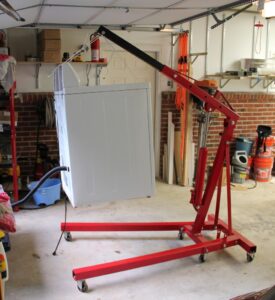 |
| engine crane lifting a washing machine |
Here an engine crane is being used to lift a washing machine. I was not feeling all that well the day I needed to move this. So I opted for a reduced stress method of getting this washing machine into the back of a truck.
Lifting with these cranes it not complex but there are a few things to be aware of.
The crane even without a load is quite hefty weighing in at upwards of 150lbs.
Since normal rope can lift significant loads and is readily available it is a nice solution for lifting things around the house. While convenient rope can stretch quite a bit when loaded. If you lift with rope be certain to take this into account, otherwise you may discover you cannot lift to the height you need because the line has stretched too much.
The load you are lifting must have its center of mass inside of the footprint of the crane. Otherwise the crane will be tip over.
The orientation of the load may change as it is lifted. You may discover as you raise the load your attachment points are not in as ideal a position as you would like. This is why it is important to inspect the load as it is being raised. The sooner the issue is found the shorter the distance you will have to lower it back down.
If you are moving things inside the house be aware of the load at the wheels of your crane. When the arms are down the wheels at the front of the base are not used (they are off the ground).
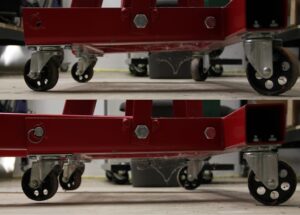 |
| Top: arms up. Bottom: arms down (not the floating wheels) |
This means the weight of the load (and the crane) is distributed on 4 wheels. If the floor is not level you will be on 3 wheels. Some interior floors may not react well to the pressures the wheels of the lift will put on them.
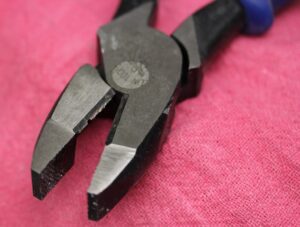 |
| my injured lineman’s tool |
So I was working in the garage installing new lights. I had verified the circuit breaker responsible for powering the circuit I would be wiring the new lights into, no problems here. Before I got around to installing the lights I realized I had other work to take care of first. So I turned the breaker back on as it was also powering outlets I needed, no problems here either.
After I was done with the sidetracking work I turned the breaker back off in preparation for wiring the lights up, no problems here either. Using my lineman’s tool I then cut the Romex line I would be reworking to run my new lights… problems.
Immediately I had lights, not of the useful overhead lighting kind, along with the popping and hissing noises which accompany shorting a live wire. I was also working on a ladder, which in this case functioned as an unnecessary excitement multiplier, which I ungracefully abandoned. The wire was roasted and my tool now had a notch of metal blasted out by the short circuit arc.
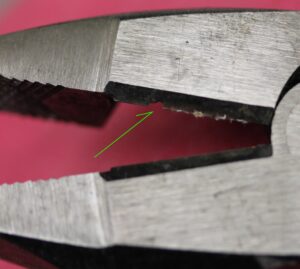 |
| closeup showing missing metal |
But the circuit breaker was off. Why was there still power?
Simple. I had turned off the wrong circuit breaker. The breaker I shut off did not have any visual manifestations which would indicate I had gotten the wrong one. So I proceeded with my work. The error was not verifying the power was off at the place and time of the work. Had I checked the line right before starting work again (I had several tools which would do this for me) I would have caught the problem.
Instead I am down one pair of pliers. A small price considering other possible outcomes.
The Task
This combination headphone/microphone line has a break in its outer casing.
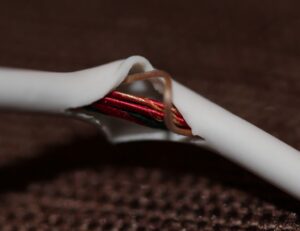 |
| The broken casing |
This causes the wire the catch on things. While the electrical connections are still good this condition is an inconvenience and needed to be repaired.
The Solution
Heat shrink tubing is perfect for this issue, expect I did not have a size of tubing on hand which would fit over the end connections of this wire and shrink down to a size necessary to grip the line.
The line could be cut and the tubing slid over it but this would entail reconnecting 4 electric lines and that is just a hassle.
I opted to use a larger diameter tubing and the build up the area to be covered with electrical tape. The tape alone would not be the best solution for this issue as unprotected it is likely to unravel.
 |
| Line prior to shrinking |
After the line was taped the tubing was placed and heated. Ideally I would have used white tubing to match the line but this was all I could find without the trouble of ordering more.
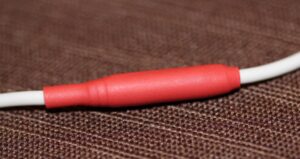 |
| The finished line |
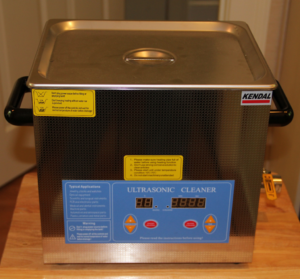 |
| an ultrasonic cleaner |
Ultrasonic cleaners function by bombarding items with sound whose frequency is beyond the range of human hearing. A discussion of the specific mechanism of cleaning is complex and beyond the intent of this post. What follows are some pointers when using a simple ultrasonic cleaner.
Overview
Ultrasonic cleaners will impart their cleaning action to the objects submerged (normally in water) inside them. As such you will only be able to effectively clean items which will fit inside the cleaner. Items with unusual aspect ratios (such as rifle barrels) will likely require a more specialized unit as their shape will not be as common.
Some units will also have heaters for heating the cleaning solution. This is an excellent feature and greatly accelerates the cleaning process. The unit pictured at the top of this page will heat the cleaning solution to about 176F (80C). For comparison most residential water heaters will heat your hot water supply to 120-140F. If you use the heating function some of the cleaning solution may evaporate from the unit and condense on the inside of the lid. Thus care should be taken when removing the lid especially if the condensate may contain corrosives (more on this later).
Cleaners will generally come with some type of wire basket for adding and removing items without getting your hands in the cleaning solution. In addition larger units will have a drain valve for emptying the cleaning solution when it becomes fouled or unusable.
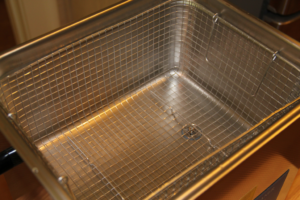 |
| cleaner interior |
Usage
Simply place the items inside the cleaner, then turn it on or set the timer. The unit does not need supervision. Certain types of items are more easily cleaned in these cleaners than by other methods. Objects having intricate shape or edges cleaning brushes could get caught on are good candidates for ultrasonic cleaning.
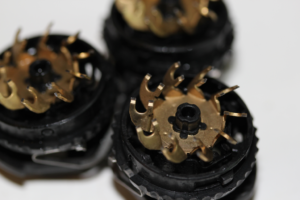 |
| electric razor blade assemblies are easily cleaned in an ultrasonic cleaner |
Often cleaning will be more effective if some type of solvent is added to the water to form a more effective cleaning solution. What you can use in your cleaner will depend on what it was designed for. Most cleaners can be used with household detergents.
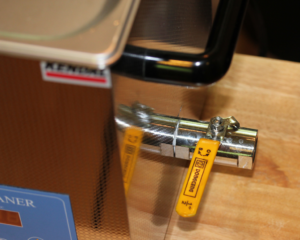 |
| cleaner drain valve |
More corrosive/awesome cleaners like sodium hydroxide should only be used if the unit is intended for use with them. Even if your cleaner is constructed of a metal body resistant to attack by corrosives (like stainless steel) other components, like the drain valve seals, may not be. In addition a single successful use of a cleaner with a powerful solvent does not indicate the unit is not suffering damage. While not immediately destroying the unit some substances may greatly reduce its working lifespan.
Ultrasonic cleaners come in a variety of sizes and prices. The one picture in the article runs about $400. Other smaller units can be less expensive but may not come with a heating function.
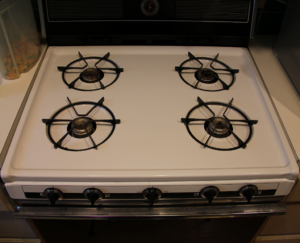 |
| The patient needing attention |
The above is my stove. It is an old stove. I think I have used this stove once in five years. I don’t really care much about the stove. Unfortunately someone recently pointed out to me the burners on the stove do not light correctly. So in accordance with my ‘fix ALL the things’ policy it was torn apart until fixed or destroyed, whichever came first. Mercifully this ended in a fixing and what follows is what I discovered.
Overview and Operation
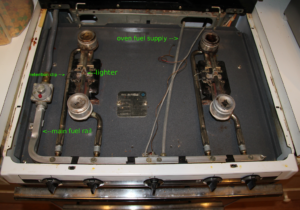 |
| stove with the top removed |
Opening the top of this stove is as simple as lifting the top from the front. Once raised the top can be slide off of its hinges exposing the amazingly primitive bits underneath. The gas line comes in from the upper left and travels down the left side to (what I think is) a regulator, a flame arrester, or both. This gas line then takes a 90 degree bend and forms the main fuel rail at the front of the stove.
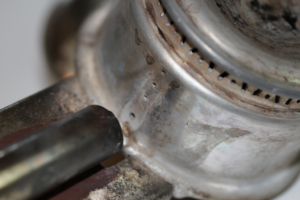 |
| closeup of the ignition flame ports |
Problems and how to clean them
Why is there a slot in the fuel line?
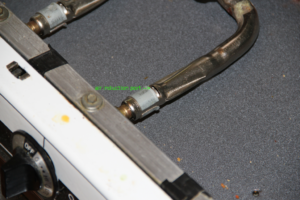 |
| air induction port |
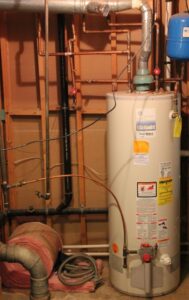 |
| Traditional 50 Gallon Natural Gas Water Heater |
Why tanks were used in the first place
Tanks have two major issues
Why tankless units are more efficient and awesome
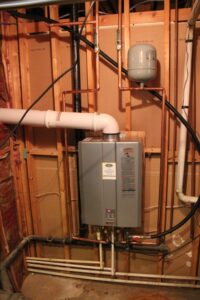 |
| Tankless Water Heater |
